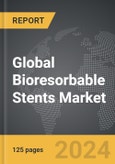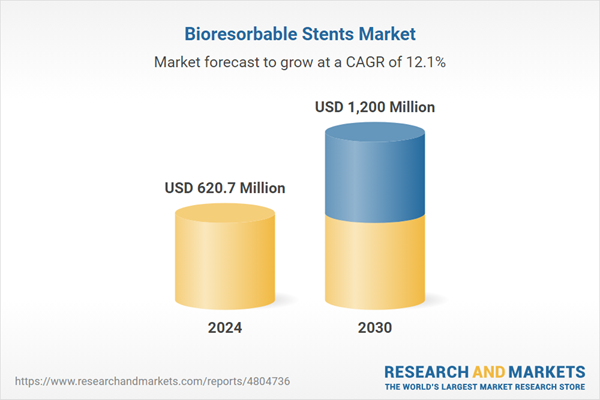The global market for Bioresorbable Stents was valued at US$620.7 Million in 2024 and is projected to reach US$1.2 Billion by 2030, growing at a CAGR of 12.1% from 2024 to 2030. This comprehensive report provides an in-depth analysis of market trends, drivers, and forecasts, helping you make informed business decisions. The report includes the most recent global tariff developments and how they impact the Bioresorbable Stents market.
The development of bioresorbable stents has been propelled by extensive research and technological innovations. These stents are engineered to provide the necessary mechanical support to the artery during the critical healing period post-angioplasty. Over time, the stent gradually degrades, reducing the risk of long-term complications. Additionally, bioresorbable stents are often coated with antiproliferative drugs to further prevent restenosis, or re-narrowing of the artery. This dual function of providing mechanical support and drug delivery enhances the therapeutic outcomes for patients. Furthermore, the use of advanced imaging techniques and precision engineering has improved the deployment and efficacy of these stents, making them a viable option for a broader range of patients and clinical scenarios.
The growth in the bioresorbable stents market is driven by several factors. Firstly, there is an increasing prevalence of cardiovascular diseases globally, particularly coronary artery disease, which necessitates effective and innovative treatment options. Secondly, the rising demand for minimally invasive procedures among patients and healthcare providers is fueling the adoption of bioresorbable stents. These stents offer a promising alternative to traditional methods, aligning with the trend towards less invasive interventions. Thirdly, technological advancements in biomaterials and stent design are enhancing the performance and safety profile of bioresorbable stents, making them more attractive to clinicians. Lastly, the growing awareness and acceptance of these stents among patients, coupled with favorable reimbursement policies in several regions, are further boosting market growth. The confluence of these factors underscores the expanding role of bioresorbable stents in modern cardiovascular treatment paradigms.
Segments: Material (Polymer-based, Metal-based); Application (Coronary Artery Disease/CAD, Peripheral Artery Disease/PAD); End-Use (Hospitals, Cardiovascular Centers).
Geographic Regions/Countries: World; Europe; Asia-Pacific; Rest of World.
The analysts continuously track trade developments worldwide, drawing insights from leading global economists and over 200 industry and policy institutions, including think tanks, trade organizations, and national economic advisory bodies. This intelligence is integrated into forecasting models to provide timely, data-driven analysis of emerging risks and opportunities.
Abstract:
Global Bioresorbable Stents Market to Reach US$1.2 Billion by 2030
The global market for Bioresorbable Stents estimated at US$620.7 Million in the year 2024, is expected to reach US$1.2 Billion by 2030, growing at a CAGR of 12.1% over the analysis period 2024-2030. Polymer-based, one of the segments analyzed in the report, is expected to record a 12.8% CAGR and reach US$905.2 Million by the end of the analysis period. Growth in the Metal-based segment is estimated at 10.3% CAGR over the analysis period.Global Bioresorbable Stents Market - Key Trends & Drivers Summarized
Bioresorbable stents, also known as bioresorbable vascular scaffolds (BVS), represent a significant advancement in interventional cardiology. These stents are designed to provide temporary support to the artery after a procedure, gradually dissolving over time and leaving behind a natural vessel. Unlike traditional metal stents, which remain permanently in the body, bioresorbable stents are composed of materials like polylactic acid (PLA) that naturally break down and are absorbed by the body. This temporary nature reduces the long-term risks associated with permanent implants, such as chronic inflammation and late-stage thrombosis. Clinical trials have demonstrated the efficacy of bioresorbable stents in treating coronary artery disease, showing comparable outcomes to metallic stents with the added benefit of restoring the vessel's natural function and flexibility over time.The development of bioresorbable stents has been propelled by extensive research and technological innovations. These stents are engineered to provide the necessary mechanical support to the artery during the critical healing period post-angioplasty. Over time, the stent gradually degrades, reducing the risk of long-term complications. Additionally, bioresorbable stents are often coated with antiproliferative drugs to further prevent restenosis, or re-narrowing of the artery. This dual function of providing mechanical support and drug delivery enhances the therapeutic outcomes for patients. Furthermore, the use of advanced imaging techniques and precision engineering has improved the deployment and efficacy of these stents, making them a viable option for a broader range of patients and clinical scenarios.
The growth in the bioresorbable stents market is driven by several factors. Firstly, there is an increasing prevalence of cardiovascular diseases globally, particularly coronary artery disease, which necessitates effective and innovative treatment options. Secondly, the rising demand for minimally invasive procedures among patients and healthcare providers is fueling the adoption of bioresorbable stents. These stents offer a promising alternative to traditional methods, aligning with the trend towards less invasive interventions. Thirdly, technological advancements in biomaterials and stent design are enhancing the performance and safety profile of bioresorbable stents, making them more attractive to clinicians. Lastly, the growing awareness and acceptance of these stents among patients, coupled with favorable reimbursement policies in several regions, are further boosting market growth. The confluence of these factors underscores the expanding role of bioresorbable stents in modern cardiovascular treatment paradigms.
Report Scope
The report analyzes the Bioresorbable Stents market, presented in terms of units. The analysis covers the key segments and geographic regions outlined below.Segments: Material (Polymer-based, Metal-based); Application (Coronary Artery Disease/CAD, Peripheral Artery Disease/PAD); End-Use (Hospitals, Cardiovascular Centers).
Geographic Regions/Countries: World; Europe; Asia-Pacific; Rest of World.
Key Insights:
- Market Growth: Understand the significant growth trajectory of the Polymer-based segment, which is expected to reach US$905.2 Million by 2030 with a CAGR of a 12.8%. The Metal-based segment is also set to grow at 10.3% CAGR over the analysis period.
Why You Should Buy This Report:
- Detailed Market Analysis: Access a thorough analysis of the Global Bioresorbable Stents Market, covering all major geographic regions and market segments.
- Competitive Insights: Get an overview of the competitive landscape, including the market presence of major players across different geographies.
- Future Trends and Drivers: Understand the key trends and drivers shaping the future of the Global Bioresorbable Stents Market.
- Actionable Insights: Benefit from actionable insights that can help you identify new revenue opportunities and make strategic business decisions.
Key Questions Answered:
- How is the Global Bioresorbable Stents Market expected to evolve by 2030?
- What are the main drivers and restraints affecting the market?
- Which market segments will grow the most over the forecast period?
- How will market shares for different regions and segments change by 2030?
- Who are the leading players in the market, and what are their prospects?
Report Features:
- Comprehensive Market Data: Independent analysis of annual sales and market forecasts in US$ Million from 2024 to 2030.
- In-Depth Regional Analysis: Detailed insights into key markets, including the U.S., China, Japan, Canada, Europe, Asia-Pacific, Latin America, Middle East, and Africa.
- Company Profiles: Coverage of players such as Abbott Laboratories, Inc., Boston Scientific Corporation, Biotronik SE & Co. KG, Eurocor GmbH, Biosensors International Group Ltd. and more.
- Complimentary Updates: Receive free report updates for one year to keep you informed of the latest market developments.
Some of the 25 companies featured in this Bioresorbable Stents market report include:
- Abbott Laboratories, Inc.
- Boston Scientific Corporation
- Biotronik SE & Co. KG
- Eurocor GmbH
- Biosensors International Group Ltd.
- Elixir Medical Corporation
- InSitu Technologies, Inc.
- Kyoto Medical Planning Co., Ltd.
- Medinol Ltd.
- Lepu Medical Technology (Beijing) Co., Ltd.
- Alvimedica Saglik Ekipmanlari Pazarlama Satis ve Dagitim A.S.
- Meril Life Sciences Pvt., Ltd.
- Arterial Remodeling Technologies SA
- iVascular S.L.U
- Endocor GmbH
Tariff Impact Analysis: Key Insights for 2025
Global tariff negotiations across 180+ countries are reshaping supply chains, costs, and competitiveness. This report reflects the latest developments as of April 2025 and incorporates forward-looking insights into the market outlook.The analysts continuously track trade developments worldwide, drawing insights from leading global economists and over 200 industry and policy institutions, including think tanks, trade organizations, and national economic advisory bodies. This intelligence is integrated into forecasting models to provide timely, data-driven analysis of emerging risks and opportunities.
What’s Included in This Edition:
- Tariff-adjusted market forecasts by region and segment
- Analysis of cost and supply chain implications by sourcing and trade exposure
- Strategic insights into geographic shifts
Buyers receive a free July 2025 update with:
- Finalized tariff impacts and new trade agreement effects
- Updated projections reflecting global sourcing and cost shifts
- Expanded country-specific coverage across the industry
Table of Contents
I. METHODOLOGYMII. EXECUTIVE SUMMARY2. FOCUS ON SELECT PLAYERSIII. MARKET ANALYSISIV. COMPETITION
1. MARKET OVERVIEW
3. MARKET TRENDS & DRIVERS
4. GLOBAL MARKET PERSPECTIVE
EUROPE
ASIA-PACIFIC
REST OF WORLD
Companies Mentioned (Partial List)
A selection of companies mentioned in this report includes, but is not limited to:
- Abbott Laboratories, Inc.
- Boston Scientific Corporation
- Biotronik SE & Co. KG
- Eurocor GmbH
- Biosensors International Group Ltd.
- Elixir Medical Corporation
- InSitu Technologies, Inc.
- Kyoto Medical Planning Co., Ltd.
- Medinol Ltd.
- Lepu Medical Technology (Beijing) Co., Ltd.
- Alvimedica Saglik Ekipmanlari Pazarlama Satis ve Dagitim A.S.
- Meril Life Sciences Pvt., Ltd.
- Arterial Remodeling Technologies SA
- iVascular S.L.U
- Endocor GmbH
Table Information
| Report Attribute | Details |
|---|---|
| No. of Pages | 125 |
| Published | April 2025 |
| Forecast Period | 2024 - 2030 |
| Estimated Market Value ( USD | $ 620.7 Million |
| Forecasted Market Value ( USD | $ 1200 Million |
| Compound Annual Growth Rate | 12.1% |
| Regions Covered | Global |









